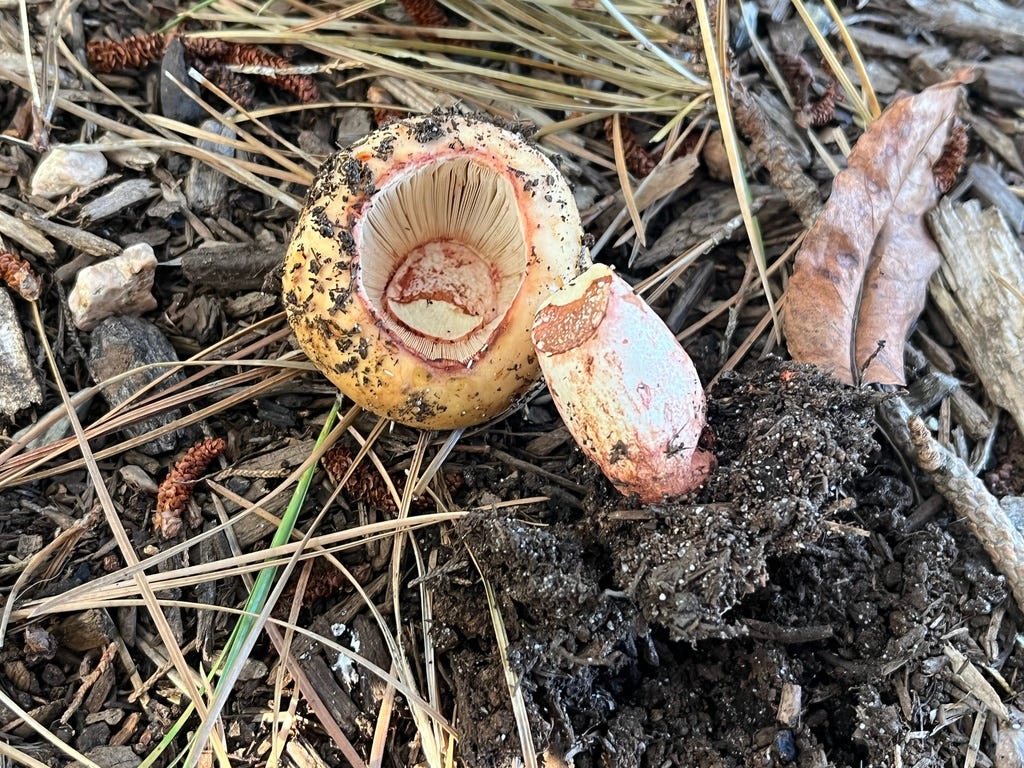Good afternoon friends, and Happy Labor Day!
This week’s publication may seem a bit wistful as today’s the unofficial end of summer, but the temps are ramping up this week so it certainly won’t feel like fall just yet. I spent the long weekend visiting family up on the sandy soils of Falmouth, MA which produced this week’s mushroom, Russula ventricosipes. I accompanied my “niece” (cousin’s daughter) and her parents to the local playground, an unusual spot for a 29 year old male without kids, but we were able to spin it into content. After having my run of the jungle gym, I took to the trees on the periphery where I flipped over some of the abundant Russulas and realized these were a distinct, identifiable species.
The mushroom isn’t found frequently enough to have a common name, but I thought “sandy shrimp” wasn’t half bad. The mushrooms are smelly, have light pink stipes (stems) that are key to identification, and are typically found in sandy soil near water. If you have any better suggestions send them over.
Fun Facts
This mushroom is a member of the “Foetid Russulas”, a subgroup of ~12 species in the large genus Russula (aka brittlegills). The Foetid Russulas are characterized by tawny/beige colors and a foul odor emanating from their flesh. I looked up whether the proper spelling of the adjective is “fetid” or “foetid” and, per the all-knowing thecontentauthority.com, they’re for the most part interchangeable. The “foetid” spelling suggests that the smell is even more unpleasant than the more common “fetid” so that’s what I’ll use because these were quite rank.
In my experience, when people smell a foetid Russula some think it’s gross and others don’t mind. The scent can be described anywhere from rancid marzipan to maraschino cherries to just “mushroomy” which speaks to the subjective nature of our sense of smell. The taste is equally unpleasant (in my subjective sensory point of view).

The reddish pink on the stipe above is probably the most distinguishable characteristic after the smell. A third unique element is their growth habit. Most of the mushrooms in this fruiting were submerged up to their neck in the sandy soil. The cap formed a little mound above the ground but the stipe didn’t clear the cap from the ground at all in younger specimens. I searched the internet and some ID books to see if there was a term for this type of growth, but all I found was “mushrump” popularized by Michael Kuo of mushroomexpert.com.
It also made me wonder how is this advantageous for spore dispersal? The revered edible Matsutake (Tricholoma magnivelare), which also grows with conifers in sandy soil in the region, has a similar growth habit - perhaps an adaptation to the ecosystem? Older specimens seemed to rise a touch above the earth for better spore dispersal, but it’s a wonder why the young ones are so compact.
The species epithet, ventricosipes, comes from “ventricose” which means “having a large or protruding stomach”. No words were minced to describe the bulbous stipe of this species.
Ecology
This Russula is thought to be mycorrhizal (forming a symbiosis) with pines growing in sandy soils, but the fact that most Russulas grow with oak species make this species peculiar. The trees in the near vicinity of this fruiting were oak, pitch pine (Pinus rigida), and even eastern red cedar (Juniperus virginiana) - and the fungus could potentially be forming associations with all of them. The mushrooms can grow solitarily as individuals or in groups, and there were at least a dozen in the fruiting we found.

While the habitat may be unique, they mushrooms are apparently fairly common in Cape Cod during the months of July through October. When young, the cap has a viscid, slippery surface which makes the pine needles and sand it pushes erupts amongst adhere to the tawny cap. Similar species are all part of that group of Foetid Russulas and fortunately the aforementioned Michael Kuo made a key to help you identify your own.

I’ll be up in Phoenicia, NY for the Menla retreat this upcoming weekend. There’s still space available for one of my favorite weekends of the year. Stay cool this week and remember to hydrate these next few days,
Aubrey
mushroommonday.com - that’s right, we dropped the hyphen, big news. Website is under construction and a whole revamp is coming this fall :)
Here’s a large Fly Agaric (Amanita Muscaria var. guessowi) I found yesterday too:
References:
Kuo, M. (2005, January). Russula ventricosipes. Retrieved from the MushroomExpert.Com Web site: http://www.mushroomexpert.com/russula_ventricosipes.html
Bessette, A. R., Bessette, A., & Neill, W. J. (2001). Mushrooms of Cape Cod and the National Seashore. Syracuse University Press. p. 81 & 137
https://www.inaturalist.org/taxa/194440-Russula-ventricosipes
https://www.mobot.org/mobot/latindict/keyDetail.aspx?keyWord=ventricose








